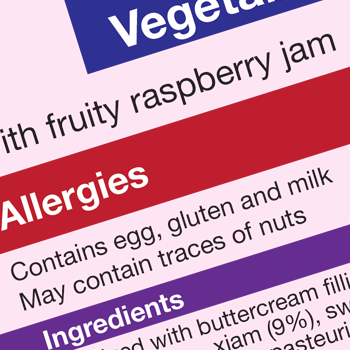Allergens: Where Food Safety and Labeling Intersect

Allergens present a unique regulatory challenge. For the small percentage of the population who suffer from an allergy to a particular type of food, a product containing that allergen can potentially cause anaphylactic shock, which can be deadly. Yet such a product poses no threat to the rest of the population.
How do U.S. laws and regulations protect the allergic consumer without unduly restricting the dietary choices of the rest of the population? The simple answer is that they mandate that food labels clearly disclose the presence of allergens, so that allergic consumers can avoid the foods that can kill them.
The viability of this solution depends on strict compliance by the food industry with the requirement of label disclosure.
It also depends on the unrelenting vigilance of allergic consumers, who must constantly check food labels for the presence of the ingredients to which they are allergic. A consumer with a peanut allergy can easily avoid peanut butter. But he/she must search the ingredient declaration of a frozen stir-fry meal to determine whether peanuts are among the numerous ingredients.
Given the potentially fatal consequences of an undeclared allergen, relying on food labels to ensure the safety of allergic consumers may not seem sufficiently protective. But, for example, prohibiting the use of peanuts in all foods to protect peanut-allergic consumers would be excessive. So, in the U.S., Congress struck the compromise of mandating clear disclosure of allergens on food labels. This article reviews the requirements that Congress imposed to ensure that this compromise is sufficient to do the job.
To be sure, the food safety requirements enforced by the U.S. Food and Drug Administration (FDA) address allergens as well. Pursuant to the Food Safety Modernization Act (FSMA), FDA implemented regulations mandating that food manufacturers protect against allergen cross-contact through both Good Manufacturing Practices (GMPs) and preventive controls. This article also reviews these requirements.
Bear in mind, however, that FDA imposed its allergen-related FSMA regulations to prevent the unintended presence of allergens in food. With respect to allergenic ingredients that manufacturers add intentionally to foods, label disclosure is the only protection.
The Allergen Hazard
According to the Mayo Clinic website,[1] food allergy affects an estimated 6 to 8 percent of children under age 3 and up to 3 percent of adults. Some children outgrow their food allergies. In many people, exposure to the relevant food can cause symptoms such as tingling, itching, or hives. In some people, however, exposure can cause life-threatening anaphylaxis, which can include constriction of the airways, a severe drop in blood pressure, shock, and loss of consciousness. Without emergency treatment, anaphylaxis can result in a coma or death.
The Food Allergen Labeling and Consumer Protection Act (FALCPA) of 2004
An FDA guidance document (FDA Allergen Guidance)[2] explains the history behind the need for legislation requiring explicit label disclosure of allergens:
As originally enacted in 1938, section 403(i) of the Federal Food, Drug, and Cosmetic Act [21 U.S.C. §343(i)] required that the label of a food that is fabricated from two or more ingredients declare each ingredient by its common or usual name (except that spices, flavorings, and colors could be declared as a class).
Although ingredient declarations complying with section 403(i) provide some information to food allergic consumers, in some cases, the common or usual name of an ingredient may be unfamiliar to consumers and many consumers do not recognize that certain ingredients contain or are derived from a food allergen.
This situation led, at least in part, to the enactment of the Food Allergen Labeling and Consumer Protection Act of 2004 (FALCPA) (Pub. L. 108-282).
In passing FALCPA, Congress noted that eight major foods or food groups—milk, eggs, fish, crustacean shellfish, tree nuts, peanuts, wheat, and soybeans—account for 90 percent of food allergies. These findings also cited a 1999 FDA review of randomly selected baked goods, ice cream, and candy showing that 25 percent of the sampled foods failed to list peanuts or eggs as ingredients on their labels, plus a study showing that many parents of children with food allergies were unable, when looking at food labels, to identify correctly the ingredients derived from major food allergens.
Congress observed that, although ingredients must be listed on food labels by their “common or usual name,” “in some cases, the common or usual name of an ingredient may be unfamiliar to consumers, and many consumers may not realize the ingredient is derived from, or contains, a major food allergen.”
FALCPA amended the Federal Food, Drug, and Cosmetic Act (FD&C Act) to address these problems: 21 U.S.C. §§ 321(qq) and 343(w). As amended, the FD&C Act requires that the label disclose the presence of an ingredient derived from one of the eight listed allergenic foods/food groups by stating its name as it appears in the statute.
This disclosure can be made in either of two ways. The statutory language describing these alternatives is confusing. As a practical matter, however, they are as follows:
1) Disclosure by Means of a “Contains” Statement – Immediately after or adjacent to the ingredient list, the label must state “Contains,” followed by the name of each of the eight listed allergenic foods/food groups from which an ingredient in the product is derived. The FD&C Act and the FDA Allergen Guidance impose certain requirements as to how the “Contains” statement must be presented.
The FDA Allergen Guidance provides this example: “Contains milk, egg, peanuts.”
2) Disclosure in the Ingredient List – If an ingredient is derived from one of the eight allergenic foods/food groups listed in the statute, but the common or usual name of that ingredient does not state its name, the declaration of the ingredient in the ingredient list must be followed by the name of the allergenic food/food group in parentheses.
The following examples illustrate this alternative:
• Semolina (wheat)
• Whey (milk)
• Lecithin (soy)
The FD&C Act requires that, in the case of tree nuts, fish, and crustacean shellfish, the label must state the particular type of nut or the particular species of fish or shellfish. The definitions section of the FD&C Act provides the following examples of the various species encompassed by the listed food groups:
• Tree nuts (e.g., almonds, pecans, or walnuts)
• Fish (e.g., bass, flounder, or cod)
• Crustacean shellfish (e.g., crab, lobster, or shrimp)
The FDA Allergen Guidance lists additional examples.
Special Cases
FDA’s label regulation for spices, flavorings, and colorings provides that such ingredients need not be listed by their specific names, but rather may be listed by category name.
This was an additional problem noted in the findings of FALCPA: “in other cases, the ingredients may be declared as a class, including spices, flavorings, and certain colorings.”
In a “Notice to Manufacturers” issued in 1996,[3] FDA stated:
[T]he agency is…considering whether an allergenic ingredient in a spice, flavor, or color should be required to be declared, 403(i)[21 U.S.C. §343(i)] notwithstanding. On a substance-by-substance basis, the agency has required ingredients covered by the exemption in section 403(i) to be declared when necessary to protect individuals who experience adverse reactions to the substance, e.g., FD&C Yellow No. 5. The agency is open to suggestions on how to best address this problem.
Through FALCPA, Congress amended the FD&C Act to mandate disclosure of the allergenic food/food group present in “a flavoring, coloring, or incidental additive that is, or that bears or contains, a major food allergen.”
Another FDA label regulation completely exempts incidental additives from declaration in the ingredients if they meet certain conditions. This was also noted as a problem in the legislative findings of FALCPA: “in other cases, the ingredients…are exempt from the ingredient labeling requirements, such as incidental additives.”
Because of the risk this exemption could pose for consumers with food allergies, FALCPA amended the FD&C Act to require label disclosure by specific name of incidental additives containing one of the eight listed foods/food groups. FDA explained the reasoning behind this change in its 1996 “Notice to Manufacturers”:
FDA reminds manufacturers that to qualify for the exemption from ingredient declaration provided for incidental additives and processing aids, a substance must meet both of the requirements of 101.100(a)(3), i.e., it must be present in the food at an insignificant level, and it must not have any technical or functional effect in the finished food.
The recent adverse reaction reports indicate that some manufacturers have…incorrectly interpreted what constitutes an insignificant level of a substance. Clearly, an amount of a substance that may cause an adverse reaction is not insignificant.
With respect to flavorings, colorings, and incidental additives containing food allergens other than the eight major food allergens listed in the FD&C Act, FALCPA amended the Act to provide authority for the issuance of regulations requiring label disclosure by name rather than by category.
Pursuant to this authority, FDA in 2008 issued a regulation requiring the colors cochineal extract and carmine to be declared by their specific names in the list of ingredients.
Exception for Highly Refined Oils
An allergic reaction does not result from every food ingredient derived from one of the eight foods/food groups listed in FALCPA. FALCPA therefore exempts highly refined oils derived from the listed foods/food groups, plus ingredients derived from such oils. The rationale is that highly refined oils contain extremely small levels of allergenic proteins, and studies have shown that allergic people can consume them safely.
The FDA Allergen Guidance makes a subtle distinction with respect to packaged foods provided by foodservice locations, such as cafeterias and restaurants, and retailers of freshly prepared food:
• FALCPA applies if the food is placed in a package for future consumption, independent of an order from a consumer.
• But FALCPA does not apply to food that is boxed or wrapped for near-term consumption in response to an order from a consumer.
Recent Developments
Rye and Barley
In 2018, FDA denied a Citizen Petition that urged the agency to issue regulations requiring the specific label disclosure of rye and barley.[4]
Sesame
The Center for Science in the Public Interest submitted a Citizen Petition in 2014 asking FDA to add sesame to the FD&C Act’s list of eight major food allergens. FDA issued a request for comments in October 2018. Over 4,800 comments were submitted. So far, FDA has not taken further action.[5]
Coconut
In September 2019, the Coconut Coalition of the Americas undertook an effort to persuade FDA to remove coconuts from the list. The coalition asserts that:
The FDA misclassified coconut, which is causing confusion for a lot of people because it shouldn’t be classified with tree nuts. Consumers with a tree nut allergy, but not a coconut allergy, are being deprived of this fruit. And, industry is being greatly impacted as contract manufacturers wanting to use coconut have to unnecessarily classify their facility as a tree nut facility when they’re not.[6]
Allergens under FSMA
FDA’s regulations implementing FSMA include 21 C.F.R. Part 117, which governs Current GMPs and Hazard Analysis and Risk-Based Preventive Controls for Human Food.
Section 117.3 defines “Allergen cross-contact” to mean “the unintentional incorporation of a food allergen into a food.”
GMPs
Subpart B of Part 117 establishes Current GMPs. Each of the following sections within that subpart imposes GMP requirements with respect to the prevention of allergen cross-contact:
• § 117.10 – Personnel
• § 117.20 – Plant and grounds
• § 117.35 – Sanitary operations
• § 117.40 – Equipment and utensils
• § 117.80 – Processes and controls
• § 117.93 – Warehousing and distribution
FDA’s 1996 “Notice to Manufacturers” explains that label statements such as “may contain peanuts” are not an acceptable substitute for GMPs:
The agency is aware that some manufacturers are voluntarily labeling their products with statements such as “may contain (insert name of allergenic ingredient).” FDA advises that, because adhering to good manufacturing practice (GMP) is essential for effective reduction of adverse reactions, such precautionary labeling should not be used in lieu of adherence to GMP.
Hazard Analysis
Subpart C of Part 117 establishes requirements as to Hazard Analysis and Risk-Based Preventive Controls. Section 117.130(a)(1) requires the operator of a food facility to conduct an analysis to identify known or reasonably foreseeable hazards. This regulation explicitly lists food allergens as hazards to be considered.
Preventive Controls
Section 117.135, which establishes requirements for preventive controls, states that such controls include, as appropriate to the facility and the food:
(a)(2)Food allergen controls. Food allergen controls include procedures, practices, and processes to control food allergens. Food allergen controls must include those procedures, practices, and processes employed for:
(i) Ensuring protection of food from allergen cross-contact, including during storage, handling, and use; and
(ii) Labeling the finished food, including ensuring that the finished food is not misbranded under section 403(w)[§343(w), which requires disclosure of allergens by specific name] of the Federal Food, Drug, and Cosmetic Act.
(3)Sanitation controls. Sanitation controls include procedures, practices, and processes to ensure that the facility is maintained in a sanitary condition adequate to significantly minimize or prevent hazards such as environmental pathogens, biological hazards due to employee handling, and food allergen hazards. Sanitation controls must include, as appropriate to the facility and the food, procedures, practices, and processes for the:
…[p]revention of allergen cross-contact and cross-contamination from insanitary objects and from personnel to food, food packaging material, and other food contact surfaces and from raw product to processed product. (Emphasis added.)
Conclusion
On October 29, 2018, in the context of FDA’s request for information about sesame allergy, then-FDA Commissioner Scott Gottlieb issued a statement that included the following, which sums up FDA’s view on this topic:
Thousands of Americans experience life-threatening, food-related reactions each year, and an estimated 20 people die from them annually. In some cases, such reactions occur despite a careful reading of packaged food labels by conscientious consumers. To me, that’s unacceptable. The FDA is committed to advancing our efforts to help ensure that Americans have access to the information they need about common allergens in packaged foods.
In particular, the undeclared presence of allergens in foods—the leading reason for food recalls—continues to be a significant public health issue and an area of active policy consideration by the agency.[7]
John M. Packman, DLA Piper LLP, can be reached at john.packman@dlapiper.com.
References
1. www.mayoclinic.org/diseases-conditions/food-allergy/symptoms-causes/syc-20355095.
2. Guidance for Industry: Questions and Answers Regarding Food Allergens, including the Food Allergen Labeling and Consumer Protection Act of 2004 (Edition 4); Final Guidance, FDA, October 2006 (FDA Allergen Guidance) (emphasis and paragraph breaks added); available at www.fda.gov/regulatory-information/search-fda-guidance-documents/guidance-industry-questions-and-answers-regarding-food-allergens-edition-4.
3. wayback.archive-it.org/7993/ 20170403234936/https://www.fda.gov/Food/GuidanceRegulation/Guidance
DocumentsRegulatoryInformation/Allergens/ucm106546.htm.
4. iegpolicy.agribusinessintelligence.informa.com/PL215400/FDA-says-rye-barley-should-not-qualify-for-major-food-allergen-list.
5. www.regulations.gov/docketBrowser?rpp=25&so=DESC&sb=commentDueDate&po=0&D=FDA-2018-N-3809.
6. www.prnewswire.com/news-releases/the-coconut-coalition-of-the-americas-launches-initiative-to-remove-coconut-from-the-fda-major-food-allergen-list-300914453.html.
7. www.fda.gov/news-events/press-announcements/statement-fda-commissioner-scott-gottlieb-md-fdas-new-consideration-labeling-sesame-allergies.
Looking for a reprint of this article?
From high-res PDFs to custom plaques, order your copy today!





